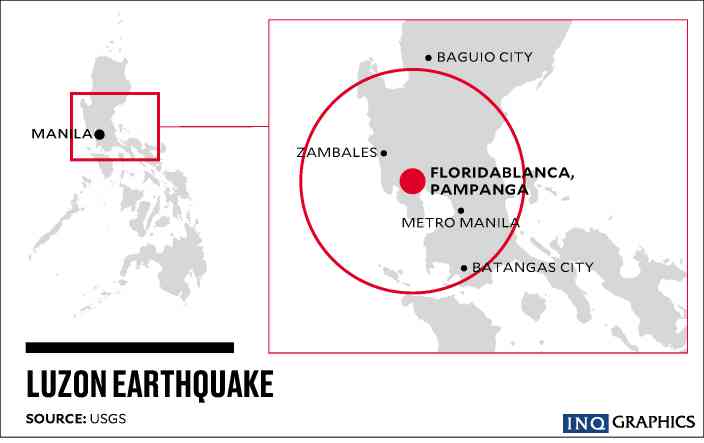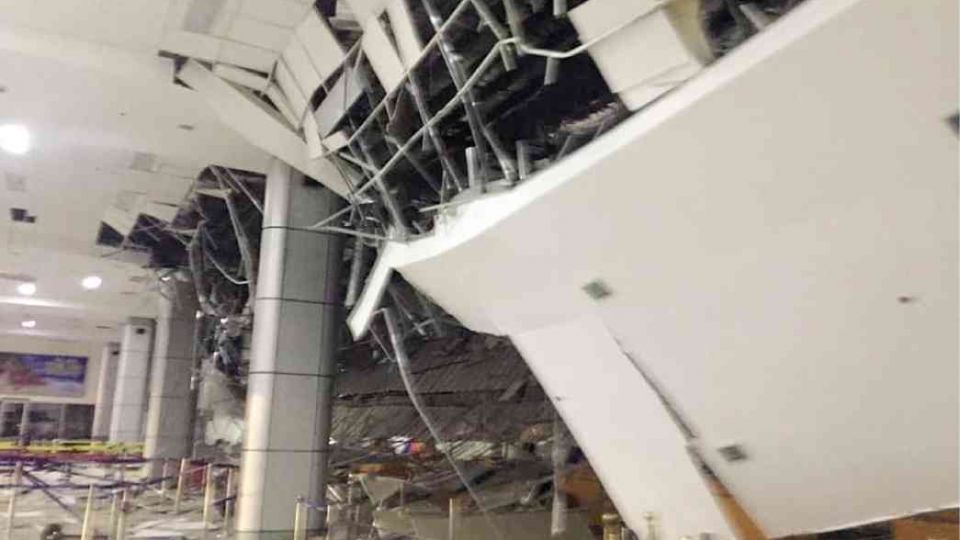April 23, 2019
The earthquake struck the central island of Luzon Monday afternoon.
Rescuers dug into rubble to reach people trapped in a supermarket that collapsed in Porac town, Pampanga province, after a 6.1-magnitude earthquake shook Luzon on Monday afternoon.
The National Disaster Risk Reduction and Management Council (NDRRMC) reported that it was verifying reports that five people were killed in the earthquake.
Three bodies were reportedly pulled out of the collapsed supermarket, but the NDRRMC said that report was “for validation.”
Pampanga Gov. Lilia Pineda reported that eight people died, including an elderly woman and her grandchild who were killed when part of a wall beside their house fell on them in Barangay Santa Cruz, Lubao town, as the earth shook.
The powerful earthquake struck at 5:11 p.m. rocking Luzon, including Metropolitan Manila, and sending thousands of people fleeing high-rises, and bringing mass transportation in the capital to a standstill.
The Philippine Institute of Volcanology and Seismology (Phivolcs) said the quake was centered on the town of Castillejos in Zambales province.
Scientists from the US Geological Survey logged the quake’s magnitude at 6.3, and said its epicenter was 40 kilometers below the earth’s surface.
Phivolcs said the quake was tectonic in origin and had a depth of 21 kilometers.
The temblor was felt at varying intensities in Metro Manila and surrounding provinces.
Intensity 5 was reported in San Felipe, Zambales; Malolos and Obando in Bulacan; Lipa, Batangas; Abucay, Bataan; Magalang, Pampanga; and in Quezon City, Valenzuela City and Manila.
The quake also shook several towns in Pangasinan, Nueva Ecija, Aurora, Cavite and Quezon provinces.
It was also felt in Baguio City.
Aftershocks in two weeks
Phivolcs Director Renato Solidum said that while the temblor was not considered a major earthquake, damage and aftershocks were expected in several areas that had been hit.
As of press time on Monday night, at least 17 aftershocks had been recorded by Phivolcs.
Phivolcs Deputy Director Bart Bautista said around 100 aftershocks were expected in a span of one to two weeks after a 6.1-magnitude earthquake.
Solidum said there was no danger of tsunami after the quake.
In Metro Manila, office workers piled out onto the streets as emergency alarms blared after the quake struck.
Pictures of shaking buildings and cracked walls flooded social media feeds, along with photos of people gathered on sidewalks after fleeing office and residential buildings.
Train runs suspended
Operations by Metro Manila’s three light-rail transport companies were suspended after the temblor, forcing thousands of commuters heading home after work to take other means of transportation.
The Philippine National Railways also suspended its operations.
Rail services will resume on Tuesday.
Several schools in the metropolis called off classes.
A building of Emilio Aguinaldo College on San Marcelino Street in Manila’s Ermita district tilted but was stopped from falling by a building on the next block.
 Operations were not affected at Ninoy Aquino International Airport in Manila, but all flights at Clark International Airport in Pampanga were canceled. The airport will be closed for 24 hours due to heavy damage to the terminal, according to the Department of Transportation.
Operations were not affected at Ninoy Aquino International Airport in Manila, but all flights at Clark International Airport in Pampanga were canceled. The airport will be closed for 24 hours due to heavy damage to the terminal, according to the Department of Transportation.
Power failures
The earthquake caused power failures in Pampanga, Pangasinan, La Union and Bataan.
Fire broke out at Bataan Refinery Center in Limay town during the earthquake.
Electricity was also cut in the provinces of Quezon, Batangas, Camarines Sur and Sorsogon, but it was restored before long.
The temblor damaged a portion of the megadike in Pampanga.
The 57-kilometer megadike—stretching through the City of San Fernando and the towns of Bacolor, Porac and Santa Rita—is the province’s last defense against lahar flows from Mt. Pinatubo.
In Porac, Santa Catalina Church was “significantly damaged,” according to a post by the Archdiocesan Committee on Church Heritage.
The cross on top of the belfry of St. Augustine Church in Lubao, said to be the oldest church in Pampanga, was slightly damaged.



